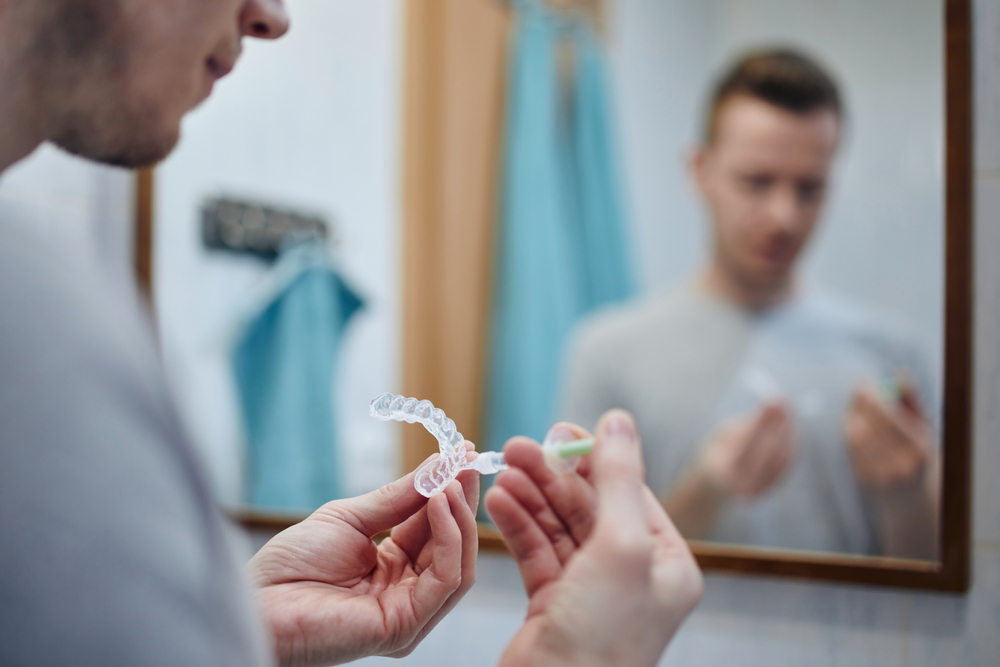Ever looked in the mirror and wished your smile was just a few shades brighter? If so, you’re not alone. Teeth whitening is one of the most popular cosmetic dental procedures today. But with so many options available—from quick in-office treatments to DIY at-home kits—it’s easy to feel overwhelmed. Which one works best? How much do they cost? And are the results worth it? In this blog, we’ll explore the key differences between in-office and at-home teeth whitening to help you decide which path leads to your perfect smile.
In This Blog:
- What is In-Office Teeth Whitening?
- What is At-Home Teeth Whitening?
- Key Differences
- Pros and Cons of Each Option
- Which Option is Right for You?
- Maintaining Your Whitened Smile
What is In-office Teeth Whitening?
In-office teeth whitening is the gold standard for achieving a noticeably brighter smile in the shortest amount of time. This procedure is done at your dentist’s office and uses powerful whitening agents, often activated by a special light or laser, to deliver dramatic results. Since it’s performed under professional supervision, you can trust that it’s both safe and effective.
Here’s how it works: your dentist starts by protecting your gums and soft tissues with a barrier, then applies a high-concentration whitening gel to your teeth. Depending on the system, a light or laser may be used to enhance the whitening process. In just one session—usually about an hour or two—you can see your teeth lighten by several shades. It’s a great option if you’re preparing for a big event or just want a fast, professional boost to your smile.
While in-office whitening tends to be pricier than at-home alternatives, the quick, reliable, and professionally tailored results often make it well worth the investment.
What is At-home Teeth Whitening?
At-home teeth whitening is all about flexibility and convenience. Whether you pick up a kit at the store or get a custom system from your dentist, this option lets you whiten your teeth at your own pace, from the comfort of home.
With custom kits from your dentist, you’ll get trays made specifically for your teeth, ensuring a snug fit and even application of the whitening gel. These kits use a professional-grade gel, though it’s not as strong as what’s used in the office. You’ll wear the trays for a set amount of time each day, and you can expect to see results in about one to two weeks.
Over-the-counter products, like whitening strips or one-size-fits-all trays, are super easy to use and budget-friendly. Some kits even include LED lights to speed things up. However, since these aren’t customized, you might not get the same level of even whitening as you would with a dentist-prescribed kit.
The big draw of at-home whitening is its affordability and convenience, but you’ll need to commit to daily use for the best results. It’s a great choice if you’re looking for gradual improvement and don’t mind putting in a little time and effort.
Key Differences Between In-office and At-home Whitening
Choosing between in-office and at-home teeth whitening can feel overwhelming, but the decision really comes down to what you’re looking for. Let’s break it down:
Effectiveness:
In-office whitening is powerful. With professional-grade whitening agents and advanced tools, it can lighten your teeth by several shades in just one visit. At-home treatments work well too, but they’re more gradual—you’ll need to use them consistently over time to see results.
Speed:
If you’re in a rush to brighten your smile, in-office whitening is your best bet. You can walk out of the dentist’s office with a noticeably whiter smile in just an hour or two. At-home kits take a little more patience, usually delivering results after one to two weeks of daily use.
Safety:
Professional whitening is done under expert supervision, so there’s minimal risk of sensitivity or gum irritation. At-home options are safe when used correctly, but you need to follow the instructions carefully to avoid any issues.
Customization:
In-office treatments are tailored to your specific needs, ensuring even and consistent whitening. With at-home options, custom trays from your dentist offer a similar level of precision, but over-the-counter kits are more of a one-size-fits-all solution.
Cost:
In-office treatments are more expensive due to their advanced technology and professional oversight. At-home options are more budget-friendly, with a range of products to fit your price point.
Quick Comparison Table: In-office vs. At-home Whitening
| Feature | In-office Whitening | At-home Whitening |
| Effectiveness | High; noticeable after one session | Moderate; gradual improvement over time |
| Speed | Immediate results | Takes 1–2 weeks or longer for results |
| Safety | Supervised by professionals | Safe with proper use; misuse risks exist |
| Customization | Fully tailored to your needs | Custom trays (dentist-provided) or OTC options |
| Cost | Higher cost | More affordable, varies by product |
Ultimately, the choice depends on your goals, timeline, and budget. Both options can lead to a brighter smile—you just need to decide which approach works best for you.
Pros and Cons of Each Option
When weighing your teeth whitening options, it helps to consider the benefits and drawbacks of each. Here’s a closer look:
In-office Whitening: Pros and Cons
Pros:
- Fast, dramatic results in just one session.
- Performed under professional supervision for safety and precision.
- Tailored treatments to meet your specific needs.
Cons:
- Higher cost compared to at-home options.
- Requires scheduling and visiting a dental office.
At-home Whitening: Pros and Cons
Pros:
- Convenient and can be done on your own schedule.
- Affordable, with options for every budget.
- Gradual results allow you to control the whitening process.
Cons:
- Takes longer to see noticeable results.
- Risk of uneven whitening or gum irritation if not used correctly.
Whether you’re looking for quick results or a more budget-friendly approach, there’s a teeth whitening solution for you. Consulting with your dentist can help you find the perfect fit to achieve the bright smile you’ve been dreaming of!
Which Option is Right for You?
Deciding between in-office and at-home teeth whitening can feel tricky, but it really comes down to what works best for you. Start by thinking about your goals and lifestyle:
What’s your budget?
If you’re looking for a cost-effective solution, at-home whitening is a great choice. Over-the-counter products and custom trays from your dentist are more budget-friendly. But if you want instant results and don’t mind the higher price tag, in-office whitening might be worth the splurge.
How soon do you want results?
For a quick transformation—like before a wedding or big event—in-office treatments are the way to go. You’ll leave with a brighter smile after just one visit. If you’re okay with a gradual process, at-home options give you control over your whitening timeline.
How severe are your stains?
Deep discoloration might need the professional strength of in-office treatments, while at-home methods are great for light to moderate stains.
What’s most convenient?
At-home whitening lets you work at your own pace and in the comfort of your home. In-office treatments require scheduling a visit, but you get the benefit of expert supervision.
Do you have sensitive teeth?
If sensitivity is a concern, your dentist can adjust an in-office treatment to reduce discomfort. At-home kits are also safe, but you’ll need to follow instructions carefully to avoid irritation.
The best option is the one that fits your needs. If you’re unsure, talk to your dentist—they can guide you to the perfect solution for a whiter, healthier smile!
Maintaining Your Whitened Smile
Once you’ve achieved your dream smile, keeping it bright and beautiful is the next step. Thankfully, a few simple habits can go a long way:
- Watch what you eat and drink: Coffee, tea, red wine, and even some sauces can stain your teeth over time. If you indulge, rinse with water or drink through a straw to reduce contact with your teeth.
- Stick to good oral hygiene: Brush twice a day with a whitening toothpaste and floss regularly to prevent plaque buildup and staining. An electric toothbrush can help give your teeth a deeper clean.
- Don’t skip your dental cleanings: Professional cleanings help remove surface stains and keep your smile bright. Plus, regular checkups catch any potential issues early.
- Touch up when needed: Over time, your teeth may naturally lose a bit of their brightness. A quick touch-up—whether at home or in-office—can keep your smile looking fresh.
- Say no to tobacco: Smoking or chewing tobacco can undo all your whitening efforts. Quitting not only protects your teeth but also benefits your overall health.
- Hydrate: Drinking plenty of water helps rinse away food particles and staining agents, keeping your smile sparkling.
With these tips, you can enjoy your whiter smile for years to come. Whether you’ve chosen in-office or at-home whitening, a little effort goes a long way in maintaining those dazzling results!
Conclusion
Whitening your teeth is a simple way to boost your confidence and enhance your smile. Whether you go for the quick, professional results of in-office whitening or the convenience and affordability of at-home treatments, there’s an option for everyone. The key is finding what fits your needs and sticking to good habits to maintain your results. With a little effort, your bright, beautiful smile will keep shining for months—or even years—to come!



